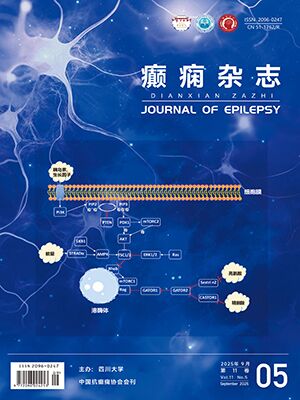| 1. |
Wiebe S, Bellhouse DR, Fallahay C, et al. Burden of epilepsy:the Ontario Health Survey. Can J Neurol Sci, 1999, 26(11):263-270.
|
| 2. |
Kwan P, Brodie MJ. Early identification of refractory epilepsy. N EnglJ Med,2000, 342(8):314-319.
|
| 3. |
Berg AT, Berkovic SF, Brodie MJ, et al. Revised terminology and concepts for organization of seizures and epilepsies:report of the ILAE Commission on Classification and Terminology, 2005-2009.Epilepsia,2010, 51(7):676-685.
|
| 4. |
Chawla S, Aneja S, Kashyap R, et al. Etiology and clinical predictors of intractable epilepsy. Pediatr Neurol,2002, 27(3):186-191.
|
| 5. |
Mefford HC, Yendle SC, Hsu C, et al. Rare copy number variants arean important cause of epileptic encephalopathies. Ann Neurol,2011, 70(11):974-985.
|
| 6. |
Lemke JR, Riesch E, Scheurenbrand T, et al. Targeted next generationsequencing as a diagnostic tool in epileptic disorders. Epilepsia,2012, 21(5):1387-1398.
|
| 7. |
Martin HC, Kim GE, Pagnamenta AT, et al. Clinical whole-genome sequencing in severe early-onset epilepsy reveals new genes and improves molecular diagnosis. Hum Mol Genet,2014, 23(6):3200-3211.
|
| 8. |
Jain-Ghai S, Mishra N, Hahn C, et al. Fetal onset ventriculomegalyand subependymal cysts in a pyridoxine dependent epilepsy patient.Pediatrics,2014, 133(11):e1092-e1096.
|
| 9. |
Guerin A, Aziz AS, Mutch C, et al. Pyridox(am)ine-5-phosphateoxidase deficiency treatable cause of neonatal epileptic encephalopathy with burst suppression:case report and review of theliterature. J Child Neurol, 2014, 27(10):829.
|
| 10. |
Munoz T, Patel J, Badilla-Porras R, et al. Severe scoliosis in a patientwith severe methylenetetrahydrofolate reductase deficiency. BrainDev, 2014,37(6):168-170.
|
| 11. |
Mercimek-Mahmutoglu S, Cordeiro D, Nagy L, et al. Lysine restricteddiet and mild cerebral serotonin deficiency in a patient with pyridoxinedependent epilepsy caused by ALDH7A1 genetic defect. Mol GenetMetab Rep,2014, 1(7):124-128.
|
| 12. |
Olson H, Shen Y, Avallone J, et al. Copy number variation plays animportant role in clinical epilepsy. Ann Neurol,2014, 75(7):943-958.
|
| 13. |
Wang D, Pascual JM, De Vivo D. Glucose transporter type 1deficiency syndrome. In Pagon RA, Adam MP, Ardinger HH, Bird TD,Dolan CR, Fong CT, Smith RJH, Stephens K (Eds) GeneReviews. Seattle, WA:University of Washington, Seattle; 1993:1-256.
|
| 14. |
Kodera H, Mitsuhiro K, Nord AS, et al. Targed capture andsequencing for detection of mutation causing early onset epilepticencephalopathy. Epilepsia,2013, 54(3):1262-1269.
|
| 15. |
Carvill GL, Heavin SB, Yendle SC, et al. Targeted resequencing inepileptic encephalopathies identifies de novo mutations in CHD2 and SYNGAP1. Nat Genet,2013, 45(4):825-830.
|
| 16. |
Della Mina E, Ciccone R, Brustia F, et al. Improving moleculardiagnosis in epilepsy by a dedicated high-throughput sequencingplatform. Eur J Hum Genet,2015, 23(8):354-362.
|
| 17. |
Wang J, Gotway G, Pascual JM, et al. Diagnostic yield of clinicalnext-generation sequencing panels for epilepsy. JAMA Neurol,2014, 71(10):650-651.
|
| 18. |
Veeramah KR, Johnstone L, Karafet TM, et al. Exome sequencingreveals new causal mutations in children with epilepticencephalopathies. Epilepsia,2013, 54(7):1270-1281.
|
| 19. |
Dyment DA, Tetreault M, Beaulieu CL, et al. Whole-exomesequencing broadens the phenotypic spectrum of rare pediatricepilepsy:a retrospective study. Clin Genet, 2014, 21(7):12464.
|
| 20. |
Michaud JL, Lachance M, Hamdan FF, et al. The genetic landscape ofinfantile spasms. Hum Mol Genet,2014, 23(5):4846-4858.
|
| 21. |
Allen AS,Berkovic SF. De novo mutations in epileptic encephalopathies.Nature,2013, 501(11):217-221.
|
| 22. |
Euro-epinomics-res Consortium, Epilepsy Phenome/Genome Project, Epileptic Consortium. De novo mutations in synaptictransmission genes including DNM1 cause epileptic encephalopathies.Am J Hum Genet, 2014, 95(6):360-370.
|
| 23. |
Depienne C, LeGuern E. PCDH19-related infantile epileptic encephalopathy:an unusual X-linked inheritance disorder. Hum Mutat, 2012, 33(7):627-634.
|
| 24. |
Milh M, Villeneuve N, Chouchane M, et al. Epileptic and nonepilepticfeatures in patients with early onset epileptic encephalopathy andSTXBP1 mutations. Epilepsia, 2011, 52(7):1828-1834.
|
| 25. |
Deprez L, Weckhuysen S, Holmgren P, et al. Clinical spectrum ofearly-onset epileptic encephalopathies associated with STXBP1 mutations. Neurology,2010, 75(8):1159-1165.
|
| 26. |
Miller IO, Sotero de Menezes MA. SCN1A-related seizure disorders.In Pagon RA, Adam MP, Ardinger HH, Bird TD, Dolan CR, Fong CT,Smith RJH, Stephens K (Eds) GeneReviews. Seattle, WA:University of Washington, Seattle; 1993-2014, 2007, 29[updated2014 May 15].
|
| 27. |
Nakamura K, Kato M, Osaka H, et al. Clinical spectrum ofSCN2A mutations expanding to ohtahara syndrome. Neurology, 2013, 81(10):992-998.
|
| 28. |
Veeramah KR, O'Brien JE, Meisler MH, et al. De novo pathogenic SCN8A mutation identified by whole-genome sequencing of a familyquartet affected by infantile epileptic encephalopathy and SUDEP. AmJ Hum Gene, 2012, 90(4):502-510.
|
| 29. |
Ohba C, Kato M, Takahashi S, et al. Early onset epileptic encephalopathy caused by de novo SCN8A mutations. Epilepsia, 2014, 55(3):994-1000.
|
| 30. |
Milh M, Boutry-Kryza N, Sutera-Sardo J, et al. Similar earlycharacteristics but variable neurological outcome of patients with a denovo mutation of KCNQ2. Orphanet J Rare Dis, 2013, 8(2):80.
|
| 31. |
Weckhuysen S, Mandelstam S, Suls A, et al. KCNQ2 encephalopathy:emerging phenotype of a neonatal epileptic encephalopathy. AnnNeurol, 2012, 71(8):15-25.
|
| 32. |
Wolf NI, Bast T, Surtees R. Epilepsy in inborn errors of metabolism.Epileptic Disord, 2005, 7(2):67-81.
|
| 33. |
Weber YG, Storch A, Wuttke TV, et al. GLUT1 mutations are a causeof paroxysmal exertion-induced dyskinesias and induce hemolyticanemia by a cation leak. J Clin Invest, 2008, 118(3):2157-2168.
|
| 34. |
Wilson A, Leclerc D, Saberi F, et al. Functionally null mutations inpatients with the cblg-variant form of methionine synthase deficiency.Am J Hum Genet, 1998, 63(2):409-414.
|
| 35. |
Urreizti R, Moya-Garc AA, Pino-Angeles A, et al. Molecularcharacterization of five patients with homocystinuria due to severe methylenetetrahydrofolate reductase deficiency. Clin Genet, 2010, 78(1):441-448.
|
| 36. |
Auranen M, Vanhala R, Vosman M, et al. MECP2 gene analysis inclassical Rett syndrome and in patients with Rett-like features.Neurology, 2001, 56(3):611-617.
|
| 37. |
Morris-Rosendahl DJ, Najm J, Lachmeijer AM, et al. Refining thephenotype of alpha-1a Tubulin (TUBA1A) mutation in patients withclassical lissencephaly. Clin Genet, 2008, 74(4):425-433.
|
| 38. |
Marini C, Mei D, Temudo T, et al. Idiopathic epilepsies with seizuresprecipitated by fever and SCN1A abnormalities. Epilepsia, 2007, 48(7):1678-1685.
|
| 39. |
Depienne C, Trouillard O, Saint-Martin C, et al. Spectrum of SCN1 Agene mutations associated with Dravet syndrome:analysis of 333patients. J Med Genet, 2009, 46(5):183-191.
|




